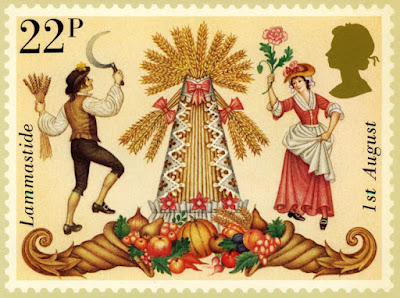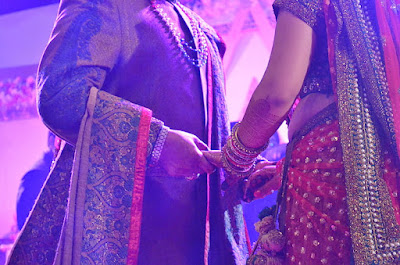The study of the origin of words and the way in which their
meanings have changed throughout history is known as etymology. Since this
blog takes a closer look at all things wedding and their origins, I thought it
would be fun to look into the origins of the word wedding. What I
found might surprise you, though if you read this blog regularly, then maybe
not.
Etymology of the word wedding
The easiest way to learn the etymology of a word these days
is to visit the online
etymology dictionary. In the case of the word wedding, the dictionary started with the Old
English weddung (n) "state of being wed; pledge, betrothal; action of
marrying." That isn’t really any different than how we think of the word
wedding today, or is it? Did those words mean something different in the past than they do today?
When you come to understand the Old English word used for the ceremony was bridelope
(bridal run) it is a heads up that maybe things didn’t quite mean the same as we
view them now. Turns out this term dates back to A.D. 950 (brydlopa). This
custom involved a ‘run for the bride-door.’ This ancient tradition was both
symbolic and actual. The bride was swept off on horseback to her husband’s home
by him. At times this act involved a helper who later was known at the best
man.
So, if we have the ceremony described as bridelope as
described above, what did the word wedding mean? The Anglo-Saxon root word wedd
(‘to gamble, wager’) first referred to livestock or other payment by the groom
to the bride’s father, as a more civilized alternative to abduction. According
to the etymology dictionary which differentiated the noun wed from the Old
English verb weddian, “to pledge oneself, covenant to do something, vow;
betroth, marry.” It moved on to the Old Norse veðja, and Danish vedde which
means “to bet, wager." Interesting. The coming together of two people in
marriage was considered a wager. I can see that. When we take our vows, we are
betting the other person will keep their promise, or at least what we assumed
the promise to mean. This carries us to the Old Frisian weddia which means "to
promise." Without going more in depth, other meanings included "to
pledge, to redeem a pledge."
20th century meaning of wedding
For more insight, I referenced a book titled Wedding Customs then and Now published in
1919 to learn what people thought in more recent times yet still long ago. The
second chapter of the book is titled “Buying Wives.” It opens with, “The
etymology of the very name ‘wedding’ betrays the character of the second stage
in the development of matrimony. The ‘wed’ was the money, horses, cattle, or
ornaments given as security by the Saxon groom and held by trustees as a pledge
and as a proof of the purchase of the bride from her father.”
When I hear the word pledge used in regard to marriage, what
comes to mind these days is the engagement
ring. It represents a promise to marry, but I’ve never thought of it as a
purchasing mechanism. Back in 18th century England, instead of just
announcing engagements, the amount accompanying a bride was proudly published. Can
you imagine?
Marriage contracts
Before Shakespeare’s time, the parson or his clerk served
like a town crier announcing from the church steps the amount given the bride
and her father. Why? This act provided witnesses to the marriage
contract. The amount paid was supposed to be around one-third of the
husband’s property. These marriage contracts stipulated exact regulations for buying
of wives. The future husband paid an amount referred to as a foster-lien. This
money was given to the parents who fostered the bride through childhood, and
these contracts were considered binding until death.
Not everyone held to the contract. Some parents reneged and fraud was not uncommon. Some fathers accepted multiple foster-liens from different men in the years before the marriage and then gave his daughter to
someone else. Another form of fraud came in the form of what we could call false advertisement today, when a father boasted of his daughter’s attributes and qualities in exaggerated terms.
Back in Saxon days, the king decreed the money be refunded in such cases. This
caused problems of its own, so another custom was initiated to help curb the
problem. They linked this new custom with a popular newlywed gift-giving tradition in which a husband gave his new wife a small
gift the morning after the marriage. The new statue said the bride “could not
be brought back after receiving such a token of contentment.”
The Church got
involved, too, and the clergy demanded fraudulent fathers who accepted more than
one lien had to pay back four times the amount if he did not deliver the bride.
Did the bride have a say?
Think of the woman’s role in all this. According to Instruction
to a Christian Woman by Louis Vives, “a decent girl should not think of
expressing any wish as to what man should be her husband.” Most of the time,
she was not consulted in the process. Many times, contracts were written up
while the couples were still babies. At the other end of this spectrum, some marriages
were postponed by relatives who didn’t want the marriage. At the extreme, is
the example of the marriage of Robert Phillips, Esq., (brother of John Phillips,
the poet), who was eighty when he married Miss Anna Bowdler, who was close to
the same age. They had been engaged for sixty years!
I don’t know about you, but I am certainly happy to be
living in this day in age in a country where I have a voice regarding my life and in a culture where the word wedding means a "marriage ceremony, especially considered as including the associated celebrations."
* * * *
Some links in this post are affiliate links. We are a
participant in the Amazon Services LLC Associates Program, an affiliate
advertising program designed to provide a means for us to earn fees by linking
to amazon.com and affiliate sites.
Thanks so much for being part of our success.
Image credits:
Record dated Nov. 25, 1486, of financial arrangements between the
Piccolomini and Bandinelli families of Siena regarding the future
marriage between Bernardinus Piccolomini and Antonia Bandinelli. Bottom
portion of manuscript cut off with loss of text.
Painting by Joseph Wright of Derby: An Experiment on a Bird in the Air Pump, by Derby, J. W. o., National Gallery, London. (https://ndla.no/article/32348).
















.png)
.png)
.png)



